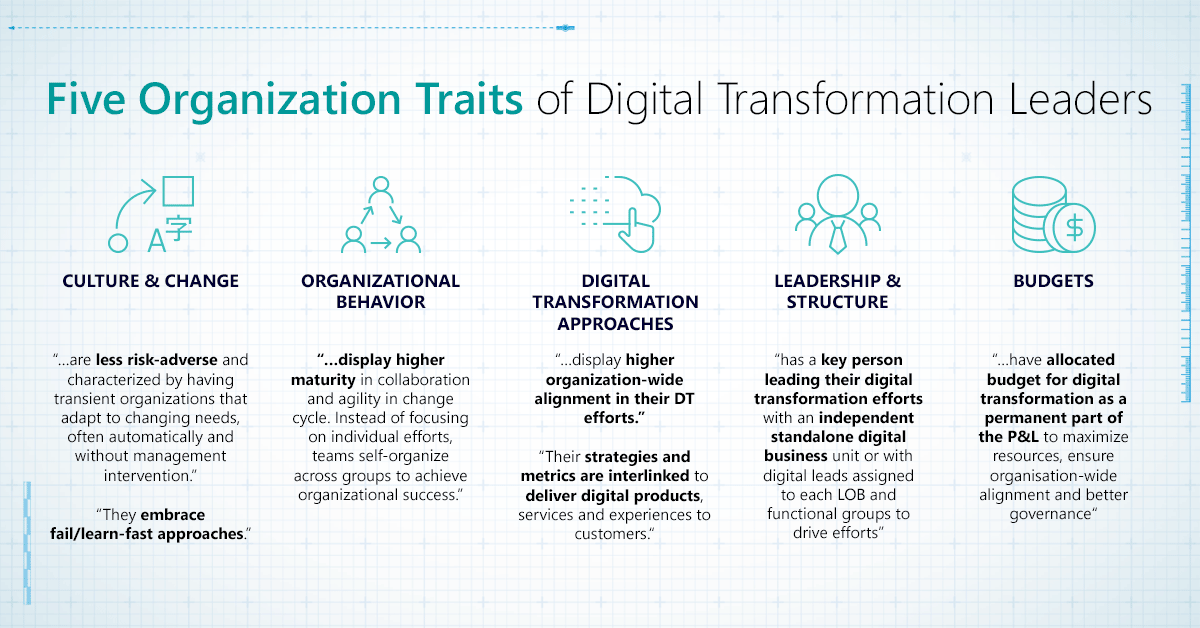How to win big in Asia Pacific’s Digital Transformation game
In the beautiful game of soccer, a selfless pass to the right teammate in the right position at the right time can make it all come together – a team’s shared determination can mean scoring the winning goal.
It is the same in the competitive game of Digital Transformation. According to a new Microsoft-commissioned IDC survey, organizations that move with pace and coordination along their Digital Transformation journeys do twice as well as their slower fragmented rivals.

The study – “Unlocking the Economic Impact of Digital Transformation—surveyed 1,560 respondents in 15 Asia Pacific economies late last year. They were from a wide range of mid and large-sized companies and organizations in manufacturing, financial services, education, healthcare, government, and retail.
Understanding the steps it takes to make a winning team in Digital Transformation has a sense of urgency in Asia as sweeping changes in technology present either a great opportunity or a tough opponent depending on the strategies.
“Digital Transformation is a team sport,” says Daniel-Zoe Jimenez, Research Director of Digital Transformation at IDC.
Jimenez goes on to explain that in an organization team structure, marketing can have a plan that differs from finance, and sales a different one too, adding that what needs to happen is that those individual plans become aligned with the overall Digital Transformation strategy.
To succeed in the new environment, coordinated teamwork across every part of an organization is essential.
“To ensure success, individual, or departmental siloed projects, need to be scaled organization-wide,” Jimenez said. ”To achieve this, business units need to collaborate and work together towards achieving the broader Digital Transformation strategy, and this also requires that the individual goals and metrics are aligned to the organization’s Digital Transformation goal.”
Leaders and Followers
Across the field of Digital Transformation, the study identifies two main players: Leaders and Followers. While 85% of the organizations surveyed by IDC have embarked on Digital Transformation journeys, only 7% can be classified as Digital Transformation “Leaders.”
These Leaders have a full digital strategy in place. They earn more than 30% of their income from digital products and services and see greater benefits from their Digital Transformation initiatives.

The study highlighted some fundamental differences in the mindsets of Leaders vs. Followers.
For instance, Leaders watch the competition more closely than Followers and the emergence of new entrants is of higher concern to them.
Understanding how to build a winning team is crucial – particularly in the fast-growing economies of Asia Pacific, where the demands of customers and market pressures are rising.
Organizational Traits of Leaders
Jimenez notes that while Leaders and Followers face similar challenges as they undergo Digital Transformation, the former are rewarded with an average of two times the benefits compared with the rest. The challenges grow for Followers, because they lack the right capabilities to tackle them.
“This is because Followers operate in silos and are reactive. Overall, they have not mastered the ‘how-to.’ Many Followers seem to know about some of the winning ingredients needed. But they fail at execution often because they lack a ‘Digital Сulture’,” Jimenez says.
What sets Leaders apart is their ability to ride the Digital Transformation wave from an organizational culture perspective. This is borne out by the study, which found that Leaders prioritize business agility and innovation, and have the following organizational traits set out in the image below.

Information Companies
“Before, everyone was asking what Digital Transformation was, and why was it needed. But now the big question is: how we can accelerate the process,” Jimenez says.
”This is where Followers are left behind, because they will adopt a wait-and-see approach and rely on others to take risks. In the world of Digital Transformation that is a losing strategy. An organization’s ability to succeed is highly dependent on driving innovation at scale and learning from failures.”
In line with this, the study shows that Leaders invest more in new and disruptive technologies like Big Data and Artificial Intelligence (AI). This helps to drive innovation and turn data assets into capital. In fact, IDC expects that by 2019, 65% of large organizations in Asia/Pacific will commit to becoming information-based companies.”

For Ralph Haupter, President of Microsoft Asia, the much-anticipated adoption of AI will accelerate the impact of Digital Transformation.
“We see AI as a primary catalyst for further growth. Our customers across Asia are already demonstrating a strong sense of urgency to integrate AI into their businesses as part of their digital transformation initiatives,” he says. “The study shows that AI is top of mind when it comes to investing in emerging technologies today.”
Digital Transformation Leaders also realize that the path to winning is not just about plug-and-play change. As well as transforming internally, an organization must learn how best to realign its entire ecosystem – including, supply chains, partners and employees.
“A big question is how to free people to be more creative and add more value,” says Jimenez.
“Leaders look at how to move beyond just having the right technical skills and focus on changing the organization’s culture. Leaders take an ecosystem-first approach in the way they create and deliver products and services to customers. Also, to become a Leader, an organization must encourage data sharing and collaboration, both internally and externally, and in an open and trusted manner.”
Measurements
In all areas of work and sport, fundamentals matter and are measured. In could be the fastest 100-meter sprint time, or how many saves a goalie makes or how many goals a striker gets. In business, numbers on a balance sheet still matter the most.
But in keeping with the times, Leaders in Digital Transformation are also taking a fresh look at their key performance indicators (KPIs). On top of traditional metrics, like profit margins, sales volumes and market share, many are looking at new ways to measure success and better gauge the performance of Digital Transformation initiatives.
A new-look KPI such as Data Capitalization could reflect how well data is used to predict customer behavior. The study found that 53% of those surveyed are starting to use data as capital asset KPIs.
Leaders are also now much more focused on leveraging data to grow revenue and productivity and measuring it as KPIs.
“Broadly, this is a three-step process: data collection helps to improve decision-making. The insight from the first step feeds the development of better products and services,” Jimenez says.” Ultimately, this can lead to new business models that will help to monetize sets of data directly or develop new commercial digital services.”

365mc Hospital: Making surgeries more IntelligentSouth Korea’s 365mc Hospital has taken a hard look at the way its surgeons learn and master techniques. Before they could only hone their skills through repeated practice. But that has changed with the introduction of Big Data and AI. Both have substantially improved the precision and safety of surgeries – so much so that the hospital is now creating a whole new business model. It hopes to soon be selling this new AI solution to other hospitals. The journey started when 365mc decided to use motion-tracking AI software and machine learning technology to consistently repeat best practices in liposuction surgery. “Liposuction depends on the surgeon’s skill at moving the cannula wand,” said Nam-Chul Kim, CEO, 365mc. “If our surgeons make a mistake on the operating table, they may damage muscle tissue. We need to empower our surgeons to make the procedure as safe and precise as possible. For that, we need to overcome the limitations of simply depending on our senses alone, and therefore technology comes into play.” 365mc started to use Internet of Things (IoT) technology to collect data from the movements of surgeons’ hands in real time. More than 2 billion movements were captured in two years. After that machine learning was used to transform these movements into patterns. This resulted in an AI solution that works like a GPS for surgeons. It guides a surgeon through an operation, and crucially sends out warnings when it anticipates possible inaccuracies and proposes immediate countermeasures. Now, 365mc recognizes that this technology can open a whole new business opportunity. We now plan to sell this intelligent solution that includes both the software and training, to other hospitals. This has transformed our business model and our revenues will increase,” said Kim. “We also see a potential for this technology to cross over into other types of surgery benefiting thousands more patients.” |
The Steps to AI
The experience of 365mc shows how data is leading to the development of innovative IT solutions based on AI. IDC predicts that by 2019, 40% of digital transformation initiatives in Asia Pacific will be supported by AI and Cognitive capabilities[1]. And again, the study shows that Leaders in Digital Transformation are investing in AI more heavily than the rest. Many see this as the start of a new era.
“AI will transform every business, improve every life and solve some of society’s most fundamental challenges,” said Harry Shum, Microsoft Executive Vice President for AI & Research.
“We believe AI technology has the power to amplify human ingenuity and extend our capabilities, so we can achieve more. When made accessible to everyone, AI will transform industries, make us more productive, and help solve society’s biggest challenges. This intelligent technology is already improving our lives today and promises to change the world tomorrow in many ways.”
Recommendations
The study sets out recommendations, including a key one for leadership that links using data across all work processes and operations.
That means creating a digital culture and capturing information in new ways. Just collating the data is the easy part. Leaders also look at potential endpoints to connect the dots and find new business and revenue models.

As seen with 365mc, a bit of serendipity is needed to recognize opportunities and create new business pathways. So, culture goes deeper than the technology and requires an ethos throughout the organization to actively pursue digital solutions.
“Leaders know where they are taking their teams and that produces a culture of collaboration across business functions,” Jimenez says. “The data strategy helps infuse the culture with a solid goal.”
But it is not just employees in one organization that make up a digital strategy and looking outside is as important as looking inwards. External Data sharing with customers, partners and even with competitors, and looking for collaboration opportunities are the keys.
“Data streams, both historical and real-time, are growing for every organization whether from internal or external sources. Blending and reconciling that data for analytics is the challenge and has to be relentless,” says Jimenez.
“Focus on bringing all of that data together to support intelligent decisions at the point of action. Then work on leveraging that data to improve products and services, and after that – to create new revenue streams.”
Recognizing that opportunity can start small is a big start. Microsoft says to look for “micro-revolutions” that can trigger bolder Digital Transformation outcomes.
“A series of micro-revolutions – small, quick projects that deliver positive business outcomes and accrue to a bigger and bolder digital transformation initiatives – are critical,” Haupter said. “This approach will ultimately enable organizations to be at the forefront of innovations and to reap benefits from new DT initiatives, leveraging the power of emerging technologies such as AI.”
Read more about how Asia-Pacific is transforming digitally:
- The US$1.16 trillion reason to take digital transformation & AI seriously in 2018
- Asia Pacific’s amazing Digital Transformation race is on with a US$1.16 trillion economic boost at stake
- Hot properties – Beating the competition in sales with AI in Hong Kong
- Digital transformation to contribute more than US$1 trillion to Asia Pacific GDP by 2021; AI is primary catalyst for further growth
[1] IDC, IDC FutureScape: Digital Transformation 2018 Predictions – Asia/Pacific (Excluding Japan) Implications















